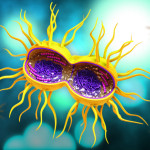The results of a recent animal study suggests researchers may be one step closer to developing a vaccine to prevent or slow HIV disease progression in people who become infected with the virus, according to an article published December 11 in the journal Vaccine and reported by Science Daily.
Some vaccines against diseases, like Polio, have relied on delivering a whole virus—either live or killed—to trigger a protective immune response against the disease. HIV is so dangerous, however, that researchers usually take fragments of the virus and combine it with other less harmful viruses. They in turn deliver the HIV fragments to the immune system to trigger a protective response. The harmless virus used to deliver the fragments is called a vector. With HIV, the vector can determine the success of the vaccine as much as the choice of which HIV fragments are used.
One promising vector that has been suggested and studied is a weakened form of the rabies virus. To determine whether a vaccine made up of a weakend rabies virus and fragments of HIV’s primate counterpart—simian immunodeficiency virus (SIV)— could monkeys against SIV infection or disease progression, Elizabeth Faul, PhD, from Thomas Jefferson University in Philadelphia, and her colleagues tested two versions of such a vaccine in 12 monkeys. Encouraging results, the authors state, would potentially pave the wave for a similar approach using HIV fragments to vaccinate humans.
Four monkeys received a vaccine, followed by a booster, combining the rabies vector with a fragment of the SIV Gag gene. Four received a vaccine that combined the vector with both the SIV Gag gene and the SIV Env gene and four monkeys received only the vector. Twelve weeks post-booster shot, the monkeys were then injected with SIV.
None of the monkeys were protected against SIV infection. The monkeys who received either the Gag vaccine or the Env plus Gag vaccine did, however, have an increase in effective antibodies against SIV, as well as significant increases in other types of immune cells—cytotoxic T-lymphocytes—that might protect against disease progression.
The authors acknowledge that the vaccine did not protect against infection, but expressed excitement that they were able to cause such a large immune response that could protect against disease progression with only two vaccine injections.
Advertisement
Advertisement
Advertisement






Comments
Comments